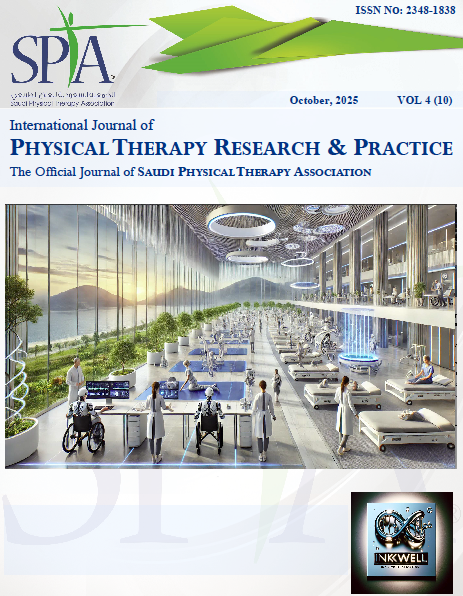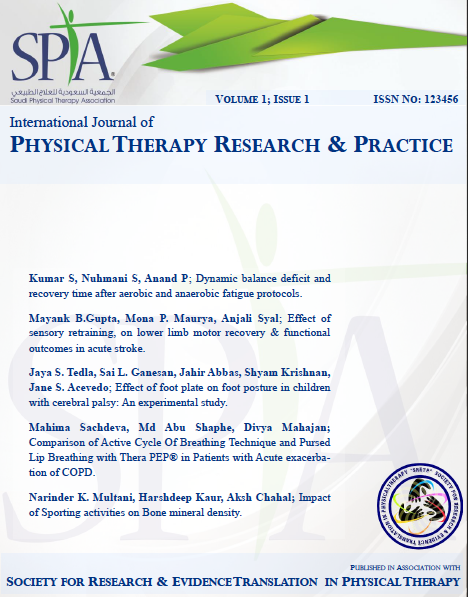Efficacy of Harness-Supported Treadmill Training Without Body-Weight Unloading on Balance and Mobility After Stroke
DOI:
https://doi.org/10.62464/9mqmb618Keywords:
Stroke rehabilitation; Treadmill gait training; Neuroplasticity; Balance recovery; Harness support; Central pattern generators; Motor relearning; Task-specific trainingAbstract
Background: Gait impairment is one of the most debilitating consequences of stroke, often restricting mobility, independence, and community reintegration. Treadmill-based gait training enhances neuroplasticity through repetitive, task-specific practice. However, body-weight-support systems are costly and not always available in routine rehabilitation. This study investigated the efficacy of harness-supported treadmill gait training without body-weight unloading compared with conventional overground therapy in individuals with post-stroke hemiplegia. Methods: Thirty adults (aged 40–60 years) with first-ever unilateral middle cerebral artery stroke and mild-to-moderate hemiparesis (Orpington Prognostic Score < 5.2) were randomly allocated to two groups: (1) conventional Bobath-based overground gait training, or (2) treadmill gait training with overhead harness support (no unloading). Both interventions were administered for 20 minutes, three times per week, over six weeks. The Stroke Rehabilitation Assessment of Movement (STREAM), Berg Balance Scale (BBS), and 10-Meter Walk Test (10MWT) served as primary outcome measures. Data were analyzed using independent t-tests, and effect sizes (Cohen’s d) were calculated. Results: Both groups showed significant within-group improvements (p < .01), but the treadmill group demonstrated superior gains in motor recovery and balance: STREAM (+6.20 ± 2.18 vs. +3.73 ± 2.16; p = .005; d = 1.17), BBS (+8.00 ± 4.19 vs. +4.20 ± 2.81; p = .025; d = 0.98), and gait velocity (+0.126 ± 0.035 m/s vs. +0.097 ± 0.025 m/s; p = .025; d = 0.90). All participants completed the program without adverse events, confirming excellent safety and adherence. Conclusion: Harness-supported treadmill gait training without body-weight support significantly enhances balance and mobility in post-stroke hemiplegia. The approach offers neuroplasticity-driven functional gains comparable to more sophisticated body-weight-supported or robotic systems, while remaining low-cost, safe, and easily implementable in routine clinical practice.
References
Adkin, A. L., & Carpenter, M. G. (2018). New insights on emotional contributions to human postural control. Frontiers in Neurology, 9, 789. https://doi.org/10.3389/fneur.2018.00789
Berg, K. O., Wood-Dauphinee, S. L., Williams, J. I., & Maki, B. (1992). Measuring balance in the elderly: Validation of an instrument. Canadian Journal of Public Health, 83(Suppl 2), S7–S11.
Bohannon, R. W. (1997). Comfortable and maximum walking speed of adults aged 20–79 years: Reference values and determinants. Age and Ageing, 26(1), 15–19. https://doi.org/10.1093/ageing/26.1.15
Calabrò, R. S., Naro, A., & Cacciola, A. (2022). Neuroplasticity and robotic-assisted gait training after stroke: Mechanistic insights. Frontiers in Neurology, 13, 874912. https://doi.org/10.3389/fneur.2022.874912
Cohen, J. (1988). Statistical power analysis for the behavioral sciences (2nd ed.). Lawrence Erlbaum Associates.
Dalton, E., Lincoln, N. B., & Smith, M. (2003). Reliability and validity of the Stroke Rehabilitation Assessment of Movement (STREAM) in stroke patients. Clinical Rehabilitation, 17(8), 890–896. https://doi.org/10.1191/0269215503cr683oa
Feigin, V. L., Stark, B. A., Johnson, C. O., Roth, G. A., Bisignano, C., Abady, G. G., & Vos, T. (2022). Global, regional, and national burden of stroke and its risk factors, 1990–2021. The Lancet Neurology, 21(10), 877–897. https://doi.org/10.1016/S1474-4422(22)00283-3
Fritz, C. O., Morris, P. E., & Rich, L. E. (2012). Effect-size estimates: Current use, calculations, and interpretation. Journal of Experimental Psychology: General, 141(1), 2–18. https://doi.org/10.1037/a0024338
Hesse, S., Bertelt, C., Jahnke, M. T., Schaffrin, A., Baake, P., Malezic, M., & Mauritz, K. H. (1995). Treadmill training with partial body-weight support compared with physiotherapy in non-ambulatory hemiparetic patients. Stroke, 26(6), 976–981. https://doi.org/10.1161/01.STR.26.6.976
Langhorne, P., Bernhardt, J., & Kwakkel, G. (2021). Stroke rehabilitation. The Lancet, 397(10291), 507–522. https://doi.org/10.1016/S0140-6736(20)32562-3
Luft, A. R., Macko, R. F., Forrester, L. W., Villagra, F., Ivey, F., Sorkin, J. D., Whitall, J., McCombe-Waller, S., Katzel, L. I., Goldberg, A. P., & Hanley, D. F. (2008). Treadmill exercise activates subcortical neural networks and improves walking after stroke: A randomized controlled trial. Stroke, 39(12), 3341–3350. https://doi.org/10.1161/STROKEAHA.108.527531
Mang, C. S., Campbell, K. L., Ross, C. J., & Boyd, L. A. (2013). Promoting neuroplasticity for motor rehabilitation after stroke: Considering aerobic exercise and genetic variation on brain-derived neurotrophic factor. Physical Therapy, 93(12), 1707–1716. https://doi.org/10.2522/ptj.20130053
Mehrholz, J., Thomas, S., & Elsner, B. (2017). Treadmill training and body-weight support for walking after stroke. Cochrane Database of Systematic Reviews, 8, CD006075. https://doi.org/10.1002/14651858.CD006075.pub4
Mishra, S., & Dutta, A. (2020). Harness-supported treadmill walking improves confidence and gait stability in subacute stroke: A pilot study. Journal of NeuroEngineering and Rehabilitation, 17(1), 75. https://doi.org/10.1186/s12984-020-00690-4
Moseley, A. M., Stark, A., Cameron, I. D., & Pollock, A. (2005). Treadmill training and body-weight support for walking after stroke. Cochrane Database of Systematic Reviews, 4, CD002840. https://doi.org/10.1002/14651858.CD002840.pub2
Olney, S. J., & Richards, C. (1996). Hemiparetic gait following stroke. Part I: Characteristics. Gait & Posture, 4(2), 136–148. https://doi.org/10.1016/0966-6362(96)01063-6
Ploughman, M., Windle, V., MacLellan, C. L., White, N., Dore, J. J., & Corbett, D. (2007). Brain-derived neurotrophic factor contributes to recovery of skilled reaching after focal ischemia in rats. Stroke, 38(7), 2403–2410. https://doi.org/10.1161/STROKEAHA.107.484287
Polese, J. C., Ada, L., Dean, C. M., Nascimento, L. R., & Teixeira-Salmela, L. F. (2013). Treadmill training is effective for ambulatory adults with stroke. Journal of Physiotherapy, 59(2), 73–80. https://doi.org/10.1016/S1836-9553(13)70158-0
Salter, K., Jutai, J., Teasell, R., Foley, N., Bitensky, J., & Bayley, M. (2005). Outcome measures in stroke rehabilitation. Evidence-Based Review of Stroke Rehabilitation, 9(1), 1–69.
Schulz, K. F., Altman, D. G., & Moher, D. (2010). CONSORT 2010 statement: Updated guidelines for reporting parallel group randomized trials. Annals of Internal Medicine, 152(11), 726–732. https://doi.org/10.7326/0003-4819-152-11-201006010-00232
Thielman, G. T., Pohl, P. S., & Sullivan, K. J. (2021). Gait and balance rehabilitation after stroke: Advances in task-specific and technology-assisted interventions. Topics in Stroke Rehabilitation, 28(7), 521–534. https://doi.org/10.1080/10749357.2021.1891979
Visintin, M., & Barbeau, H. (1998). The effects of body-weight support on the locomotor pattern of spastic paretic patients. Canadian Journal of Neurological Sciences, 25(2), 315–325. https://doi.org/10.1017/S0317167100033953
Winstein, C. J., Stein, J., Arena, R., Bates, B., Cherney, L. R., Cramer, S. C., Deruyter, F., Eng, J. J., Fisher, B., Harvey, R. L., Lang, C. E., MacKay-Lyons, M., Ottenbacher, K. J., Pugh, S., Reeves, M. J., Richards, L. G., Stiers, W., & Zorowitz, R. D. (2016). Guidelines for adult stroke rehabilitation and recovery. Stroke, 47(6), e98–e169. https://doi.org/10.1161/STR.0000000000000098
Zehr, E. P., & Loadman, P. M. (2012). Neural control of rhythmic arm and leg movement is conserved across human locomotor tasks. Exercise and Sport Sciences Reviews, 40(4), 138–143. https://doi.org/10.1097/JES.0b013e3182687c14

Downloads
Published
Issue
Section
License
Copyright (c) 2025 International Journal of Physical Therapy Research & Practice

This work is licensed under a Creative Commons Attribution-NonCommercial-NoDerivatives 4.0 International License.




